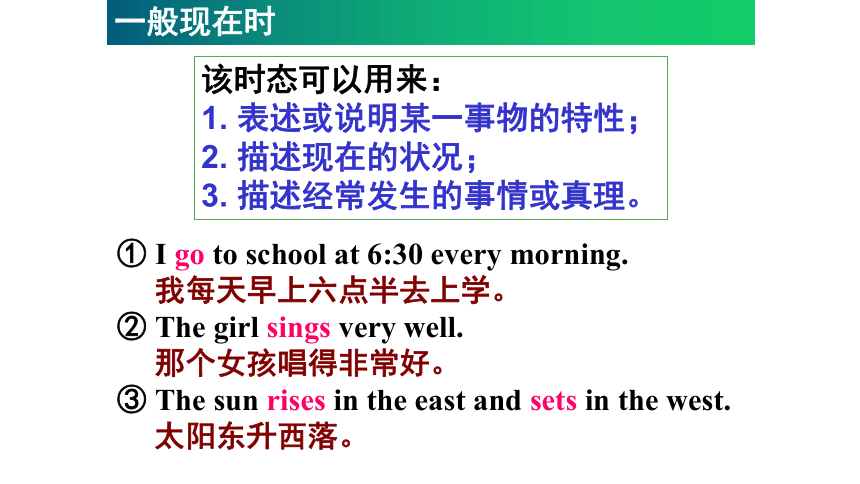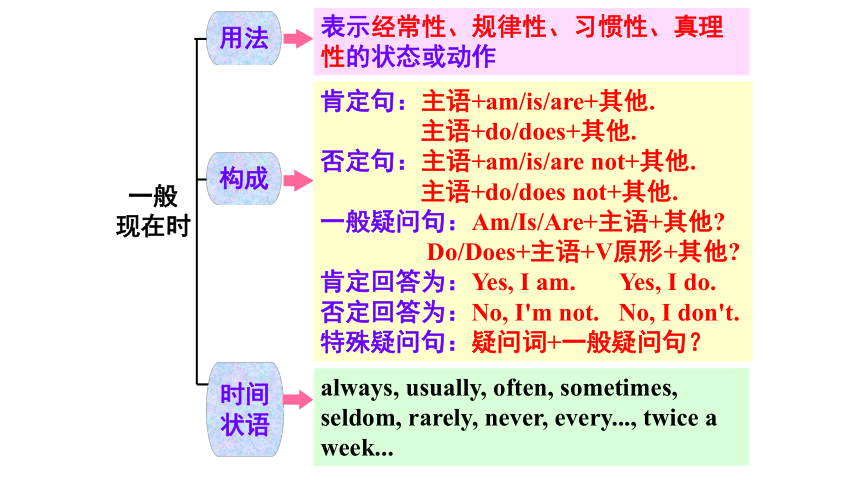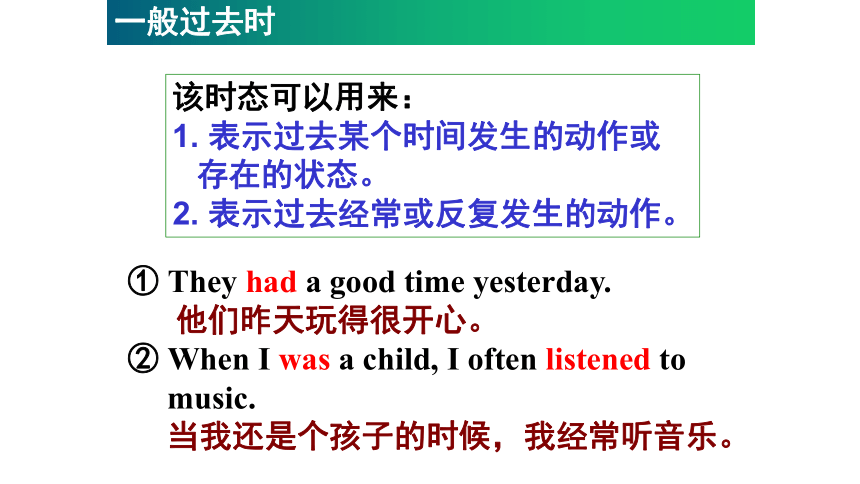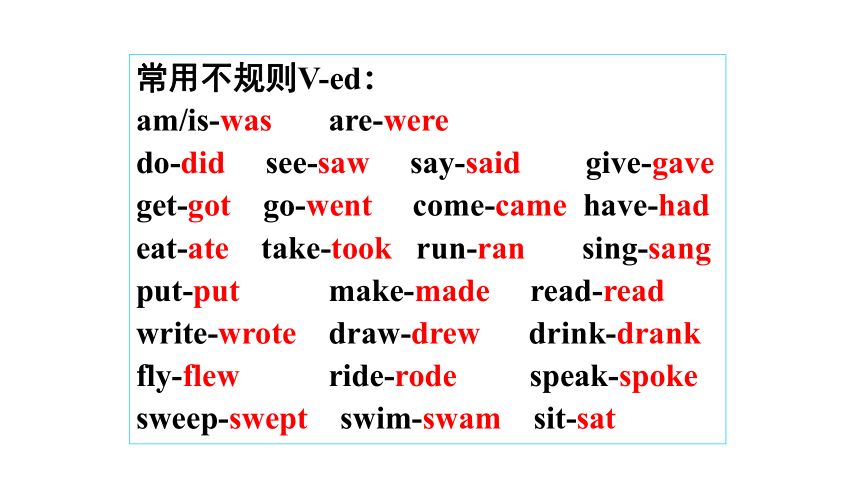八年级下Module 5 Cartoons Unit 3 Language in use 课件+嵌入音频(22张PPT)
文档属性
| 名称 | 八年级下Module 5 Cartoons Unit 3 Language in use 课件+嵌入音频(22张PPT) |  | |
| 格式 | pptx | ||
| 文件大小 | 4.3MB | ||
| 资源类型 | 教案 | ||
| 版本资源 | 外研版 | ||
| 科目 | 英语 | ||
| 更新时间 | 2022-08-06 07:29:13 | ||
图片预览









文档简介
(共22张PPT)
Module 5
Unit 3
Language in use
该时态可以用来:
表述或说明某一事物的特性;
描述现在的状况;
描述经常发生的事情或真理。
① I go to school at 6:30 every morning.
我每天早上六点半去上学。
② The girl sings very well.
那个女孩唱得非常好。
③ The sun rises in the east and sets in the west.
太阳东升西落。
一般现在时
主语人称 be动词形式
第一人称单数
第三人称单数
第一、三人称复数、第二人称
①谓语形式 Be
am
is
are
②谓语形式 Do
主语人称 实义动词形式
第一人称单数
第三人称单数
第一、三人称复数、第二人称
do(动词原形)
-s/es(第三人称单数)
do(动词原形)
实义动词第三人称单数的变化规则
1. 直接在动词后+s
like - likes play - plays
2. 以s, x, sh, ch接尾的动词:+es
wash-washes
3. 以辅音+o接尾的动词:+es
do - does go - goes
4. 以辅音+y接尾的动词:变y为i+es
fly-flies
一般
现在时
构成
用法
时间状语
表示经常性、规律性、习惯性、真理性的状态或动作
always, usually, often, sometimes, seldom, rarely, never, every..., twice a week...
肯定句:主语+am/is/are+其他.
主语+do/does+其他.
否定句:主语+am/is/are not+其他.
主语+do/does not+其他.
一般疑问句:Am/Is/Are+主语+其他
Do/Does+主语+V原形+其他
肯定回答为:Yes, I am. Yes, I do.
否定回答为:No, I'm not. No, I don't.
特殊疑问句:疑问词+一般疑问句?
① They had a good time yesterday.
他们昨天玩得很开心。
② When I was a child, I often listened to
music.
当我还是个孩子的时候,我经常听音乐。
该时态可以用来:
表示过去某个时间发生的动作或存在的状态。
表示过去经常或反复发生的动作。
一般过去时
主语人称 be动词形式
第一人称单数、第三人称单数
第一、三人称复数、第二人称
①谓语形式 Be
was
were
②谓语形式 Do
→did
V-ed变化规则
1. 一般在动词末尾加-ed, 如: pull-pulled, cook-cooked
2. 结尾是e加d, 如: taste-tasted
3. 末尾只有一个元音字母和一个辅音字母的重读闭音节, 应双写末尾的辅音字母, 再加-ed, 如: stop-stopped
4. 以“辅音字母+y”结尾的, 变y为i, 再加-ed, 如: study-studied
5. 不规则V-ed
常用不规则V-ed:
am/is-was are-were
do-did see-saw say-said give-gave
get-got go-went come-came have-had
eat-ate take-took run-ran sing-sang
put-put make-made read-read
write-wrote draw-drew drink-drank
fly-flew ride-rode speak-spoke
sweep-swept swim-swam sit-sat
一般
过去时
构成
用法
时间状语
1. 表示过去某个时间或一段时间内
发生的动作或存在的状态。
2. 表示过去经常或反复发生的动作。
yesterday, last night/week,
in 1990, two days ago, ...
陈述句:
主语+动词的过去式+句子其他成分.
含有行为动词的疑问句式:
一般疑问句:
助动词did+主语+行为动词原形
否定回答为:No, I did not (didn't).
肯定回答为:Yes, I did.
特殊疑问句:疑问词+一般疑问句
① I have already tested the program.
我已经测试了这个程序。
② I have never danced in my life.
我有生以来从没跳过舞。
③ I have recived twenty three letters.
我已经收到23封信了。
现在完成时
该时态可以用来:
表示动作已经完成并对现在有一定影响;
表示某一行为或状态从过去某时间一直持续到现在;
表示到目前为止量的积累。
现在完成时表示过去发生的动作与现在有关,指过去的动作对现在造成的影响、结果等。
already, yet, for+时间段, since+时间点
现在完成时
肯定句:
主语 + have/has + V-ed + 其他.
否定句:
主语 + haven't/hasn't + V-ed + 其他.
一般疑问句:
Have/Has + 主语 + V-ed + …?
肯定答语:
Yes, 主格代词 + have/has.
否定答语:
No, 主格代词 + haven't/hasn't.
特殊疑问句:
疑问词+一般疑问句
构成
定义
标志词
I just my lunch.
我刚吃过午饭。(现在不饿)
一般过去时 vs 现在完成时①
I my lunch in the dining hall.
我是在餐厅吃的午饭。
一般过去时单纯描述过去发生的动作。
现在完成时表示过去发生的动作与现在有关,指过去的动作对现在造成的影响、结果等。
had
have had
Note 1
他离开上海已经3天了。
He has left Shanghai for three days.
He Shanghai for three days.
It three days since he left Shanghai.
Three days since he left Shanghai.
He Shanghai three days ago.
has been away from
is/has been
has passed
left
一般过去时 vs 现在完成时②
Note 2
非延续性动词的肯定式不能与表示一段
时间的for, since或how long等状语连用.
非延续性动词
Daming: Hi, Tony. What are you reading
Tony: The Adventures of Tintin. It's fantastic. (1) ____
you ________ (ever read) a Tintin book
Daming: No, I (2) _____________ (never read) a Tintin
story. (3) ______ (be) they popular
Tony: Yes, they (4) __________ (be) popular for more
than eighty years. The first Tintin story
(5) ________ (appear) in 1929.
Daming: What does Tintin do
Tony: He (6) ______ (work) for a newspaper and he
(7) ______ (have) lots of exciting experiences.
Daming: And (8) _______ the stories ______ (have)
happy endings
Tony: Oh, yes, they always do.
Daming: Sounds great! Do you mind if I borrow your
book
ever read
have never read
Are
have been
appeared
Complete the conversation with the correct form of the words in brackets.
Have
has
do
have
works
P38
1
Complete the passage with the correct form of the words in brackets.
When I was young, I (1) __________ (not like) green vegetables. The only vegetable I (2) _____ (eat) was potatoes. I was quite small and not very strong, so I was not very good at sport. Then when I (3) ____________ (watch) television one day I saw the cartoon Popeye. When people stands next to the bad man, Bluto, he (4) ______ (look) small and weak, and when they fight, he always (5) _______ (lose). Then he eats some green vegetables. His arms (6) ______ (grow) thicker. He becomes stronger and he wins his fights. The next day I was going to play football at school, so I asked my mother for some green vegetables. I (7) _____ (score) three times and we won the match! I (8) _________ (love) green vegetables ever since.
did not like
ate
was watching
looks
loses
grow
scored
have loved
P38
2
create laugh mess own private satisfy ugly
Many people love cartoons because they are great fun. Parents and children (1) ______ together as
the Monkey King makes a terrible (2) _______ or Shrek, the (3) ______ green man, sings a song.
Cartoon heroes often live in a(n) (4) _______ world of their (5) _______. Artists (6) _______ good cartoon heroes as well as bad people. The heroes always win, and their stories (7) _______ us and help us feel safe.
laugh
mess
ugly
private
own
create
satisfy
Complete the passage with the words in the box.
P39
3
Look at the pictures and tell what they show. (Note: The pictures are in the wrong order.)
The boy must have done something wrong. So the policeman is trying to catch him.
Work in pairs and number the pictures in the correct order.
Now listen and check.
1
2
3
4
P39
4
Listen again and answer the questions.
1 Why does Betty not think the cartoon
is funny at first
2 Why does Tony think the cartoon is
really clever
Because she does not understand it at first.
Because the policeman could catch the man in the lift, but he doesn't. They both just stand there, waiting for the lift to stop!
P39
5
Read the passage and complete the sentences.
humorous faces
came to life
smiled
jumped through a ring
make films
with sound
children and older people
many more
P39
6
Time for reflection
注: word 文档
点击此处链接
Homework
1. Review the grammar we've
learnt today.
2. Finish the exercises in 《教与学》《优加》.
3. Preview the new words and
expressions in Module 6.
Module 5
Unit 3
Language in use
该时态可以用来:
表述或说明某一事物的特性;
描述现在的状况;
描述经常发生的事情或真理。
① I go to school at 6:30 every morning.
我每天早上六点半去上学。
② The girl sings very well.
那个女孩唱得非常好。
③ The sun rises in the east and sets in the west.
太阳东升西落。
一般现在时
主语人称 be动词形式
第一人称单数
第三人称单数
第一、三人称复数、第二人称
①谓语形式 Be
am
is
are
②谓语形式 Do
主语人称 实义动词形式
第一人称单数
第三人称单数
第一、三人称复数、第二人称
do(动词原形)
-s/es(第三人称单数)
do(动词原形)
实义动词第三人称单数的变化规则
1. 直接在动词后+s
like - likes play - plays
2. 以s, x, sh, ch接尾的动词:+es
wash-washes
3. 以辅音+o接尾的动词:+es
do - does go - goes
4. 以辅音+y接尾的动词:变y为i+es
fly-flies
一般
现在时
构成
用法
时间状语
表示经常性、规律性、习惯性、真理性的状态或动作
always, usually, often, sometimes, seldom, rarely, never, every..., twice a week...
肯定句:主语+am/is/are+其他.
主语+do/does+其他.
否定句:主语+am/is/are not+其他.
主语+do/does not+其他.
一般疑问句:Am/Is/Are+主语+其他
Do/Does+主语+V原形+其他
肯定回答为:Yes, I am. Yes, I do.
否定回答为:No, I'm not. No, I don't.
特殊疑问句:疑问词+一般疑问句?
① They had a good time yesterday.
他们昨天玩得很开心。
② When I was a child, I often listened to
music.
当我还是个孩子的时候,我经常听音乐。
该时态可以用来:
表示过去某个时间发生的动作或存在的状态。
表示过去经常或反复发生的动作。
一般过去时
主语人称 be动词形式
第一人称单数、第三人称单数
第一、三人称复数、第二人称
①谓语形式 Be
was
were
②谓语形式 Do
→did
V-ed变化规则
1. 一般在动词末尾加-ed, 如: pull-pulled, cook-cooked
2. 结尾是e加d, 如: taste-tasted
3. 末尾只有一个元音字母和一个辅音字母的重读闭音节, 应双写末尾的辅音字母, 再加-ed, 如: stop-stopped
4. 以“辅音字母+y”结尾的, 变y为i, 再加-ed, 如: study-studied
5. 不规则V-ed
常用不规则V-ed:
am/is-was are-were
do-did see-saw say-said give-gave
get-got go-went come-came have-had
eat-ate take-took run-ran sing-sang
put-put make-made read-read
write-wrote draw-drew drink-drank
fly-flew ride-rode speak-spoke
sweep-swept swim-swam sit-sat
一般
过去时
构成
用法
时间状语
1. 表示过去某个时间或一段时间内
发生的动作或存在的状态。
2. 表示过去经常或反复发生的动作。
yesterday, last night/week,
in 1990, two days ago, ...
陈述句:
主语+动词的过去式+句子其他成分.
含有行为动词的疑问句式:
一般疑问句:
助动词did+主语+行为动词原形
否定回答为:No, I did not (didn't).
肯定回答为:Yes, I did.
特殊疑问句:疑问词+一般疑问句
① I have already tested the program.
我已经测试了这个程序。
② I have never danced in my life.
我有生以来从没跳过舞。
③ I have recived twenty three letters.
我已经收到23封信了。
现在完成时
该时态可以用来:
表示动作已经完成并对现在有一定影响;
表示某一行为或状态从过去某时间一直持续到现在;
表示到目前为止量的积累。
现在完成时表示过去发生的动作与现在有关,指过去的动作对现在造成的影响、结果等。
already, yet, for+时间段, since+时间点
现在完成时
肯定句:
主语 + have/has + V-ed + 其他.
否定句:
主语 + haven't/hasn't + V-ed + 其他.
一般疑问句:
Have/Has + 主语 + V-ed + …?
肯定答语:
Yes, 主格代词 + have/has.
否定答语:
No, 主格代词 + haven't/hasn't.
特殊疑问句:
疑问词+一般疑问句
构成
定义
标志词
I just my lunch.
我刚吃过午饭。(现在不饿)
一般过去时 vs 现在完成时①
I my lunch in the dining hall.
我是在餐厅吃的午饭。
一般过去时单纯描述过去发生的动作。
现在完成时表示过去发生的动作与现在有关,指过去的动作对现在造成的影响、结果等。
had
have had
Note 1
他离开上海已经3天了。
He has left Shanghai for three days.
He Shanghai for three days.
It three days since he left Shanghai.
Three days since he left Shanghai.
He Shanghai three days ago.
has been away from
is/has been
has passed
left
一般过去时 vs 现在完成时②
Note 2
非延续性动词的肯定式不能与表示一段
时间的for, since或how long等状语连用.
非延续性动词
Daming: Hi, Tony. What are you reading
Tony: The Adventures of Tintin. It's fantastic. (1) ____
you ________ (ever read) a Tintin book
Daming: No, I (2) _____________ (never read) a Tintin
story. (3) ______ (be) they popular
Tony: Yes, they (4) __________ (be) popular for more
than eighty years. The first Tintin story
(5) ________ (appear) in 1929.
Daming: What does Tintin do
Tony: He (6) ______ (work) for a newspaper and he
(7) ______ (have) lots of exciting experiences.
Daming: And (8) _______ the stories ______ (have)
happy endings
Tony: Oh, yes, they always do.
Daming: Sounds great! Do you mind if I borrow your
book
ever read
have never read
Are
have been
appeared
Complete the conversation with the correct form of the words in brackets.
Have
has
do
have
works
P38
1
Complete the passage with the correct form of the words in brackets.
When I was young, I (1) __________ (not like) green vegetables. The only vegetable I (2) _____ (eat) was potatoes. I was quite small and not very strong, so I was not very good at sport. Then when I (3) ____________ (watch) television one day I saw the cartoon Popeye. When people stands next to the bad man, Bluto, he (4) ______ (look) small and weak, and when they fight, he always (5) _______ (lose). Then he eats some green vegetables. His arms (6) ______ (grow) thicker. He becomes stronger and he wins his fights. The next day I was going to play football at school, so I asked my mother for some green vegetables. I (7) _____ (score) three times and we won the match! I (8) _________ (love) green vegetables ever since.
did not like
ate
was watching
looks
loses
grow
scored
have loved
P38
2
create laugh mess own private satisfy ugly
Many people love cartoons because they are great fun. Parents and children (1) ______ together as
the Monkey King makes a terrible (2) _______ or Shrek, the (3) ______ green man, sings a song.
Cartoon heroes often live in a(n) (4) _______ world of their (5) _______. Artists (6) _______ good cartoon heroes as well as bad people. The heroes always win, and their stories (7) _______ us and help us feel safe.
laugh
mess
ugly
private
own
create
satisfy
Complete the passage with the words in the box.
P39
3
Look at the pictures and tell what they show. (Note: The pictures are in the wrong order.)
The boy must have done something wrong. So the policeman is trying to catch him.
Work in pairs and number the pictures in the correct order.
Now listen and check.
1
2
3
4
P39
4
Listen again and answer the questions.
1 Why does Betty not think the cartoon
is funny at first
2 Why does Tony think the cartoon is
really clever
Because she does not understand it at first.
Because the policeman could catch the man in the lift, but he doesn't. They both just stand there, waiting for the lift to stop!
P39
5
Read the passage and complete the sentences.
humorous faces
came to life
smiled
jumped through a ring
make films
with sound
children and older people
many more
P39
6
Time for reflection
注: word 文档
点击此处链接
Homework
1. Review the grammar we've
learnt today.
2. Finish the exercises in 《教与学》《优加》.
3. Preview the new words and
expressions in Module 6.
同课章节目录
- Module 1 Feelings and impressions
- Unit 1 It smells delicious.
- Unit 2 I feel nervous when I speak Chinese .
- Unit 3 Language in use
- Module 2 Experiences
- Unit 1 I've also entered lots of speaking competi
- Unit 2 They have seen the Pyramids.
- Unit 3 Language in use
- Module 3 Journey to space
- Unit 1 Has it arrived yet?
- Unit 2 We have not found life on any other planet
- Unit 3 Language in use
- Module 4 Seeing the docto
- Unit 1 I haven't done much exercise since I got m
- Unit 2 We have played football for a year now
- Unit 3 Language in use
- Module 5 Cartoons
- Unit 1 It's time to watch a cartoon.
- Unit 2 Tintin has been popular for over eighty yea
- Unit 3 Language in use
- Revision module A
- Module 6 Hobbies
- Unit 1 Do you collect anything ?
- Unit 2 Hobbies can make you grow as a person.
- Unit 3 Language in use
- Module 7 Summer in Los Angeles
- Unit 1 Please write to me and send me some photos
- Unit 2 Fill out a form and come to learn English
- Unit 3 Language in use
- Module 8 Time off
- Unit 1 I can hardly believe we are in the city ce
- Unit 2 We thought somebody was moving about
- Unit 3 Language in use
- Module 9 Friendship
- Unit 1 Could I ask if you've mentioned this to he
- Unit 2 I believe that the world is what you think
- Unit 3 Language in use
- Module 10 On the radio
- Unit 1 I hope that you can join us one day
- Unit 2 It seemed that they were speaking to me in
- Unit 3 Language in use
- Revision module B
